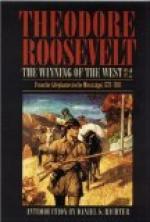During this year the Indians continually harassed the whole frontier, from Pennsylvania to Kentucky, ravaging the settlements and assailing the forts in great bands of five or six hundred warriors. [Footnote: It is most difficult to get at the number of the Indian parties; they were sometimes grossly exaggerated and sometimes hopelessly underestimated.] The Continental troops stationed at Fort Pitt were reduced to try every expedient to procure supplies. Though it was evident that the numbers of the hostile Indians had largely increased and that even such tribes as the Delawares, who had been divided, were now united against the Americans, nevertheless, because of the scarcity of food, a party of soldiers had to be sent into the Indian country to kill buffalo, that the garrison might have meat. [Footnote: State Department MSS., No. 147, Vol. VI. Reports of Board of War. March 15, 1781.] The Indians threatened to attack the fort itself, as well as the villages it protected; passing around and on each side, their war parties ravaged the country in its rear, distressing greatly the people; and from this time until peace was declared with Great Britain, and indeed until long after that event, the westernmost Pennsylvanians knew neither rest nor safety. [Footnote: Do., No. 148, Vol. I.. January 4, 1781; No. 149, Vol. I., August 6, 1782; No. 149, Vol. II., p. 461; No. 149, Vol. III., p. 183. Federal garrisons were occasionally established at, or withdrawn from, other posts on the upper Ohio besides Fort Pitt; but their movements had no permanent value, and only require chronicling by the local, State, or county historians. In 1778 Fort McIntosh was built at Beaver Creek, on the north bank of the Ohio, and Fort Laurens seventy miles towards the interior. The latter was soon abandoned; the former was in Pennsylvania, and a garrison was kept there.] Among many others the forted village at Wheeling was again attacked. But its most noteworthy siege occurred during the succeeding summer, when [Footnote: The commanders at the unmolested forts and the statesmen who stayed at home only saw those members of the tribes who claimed to be peaceful, and invariably put the number of warriors on the warpath at far too low a figure. Madison’s estimates, for instance, were very much out of the way, yet many modern critics follow him.] Simon Girty, with fife and drum, led a large band of Indians and Detroit rangers against it, only to be beaten off. The siege was rendered memorable by the heroism of a girl, who carried powder from the stockade to an outlying log-house, defended by four men; she escaped unscathed because of her very boldness, in spite of the fire from so many rifles, and to this day the mountaineers speak of her deed. [Footnote: See De Haas, 263-281, for the fullest, and probably most accurate, account of the siege; as already explained he is the most trustworthy of the border historians. But it is absolutely impossible to find out the real facts concerning




